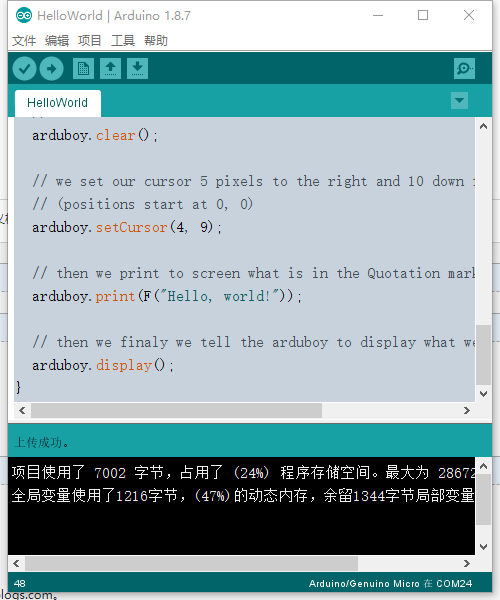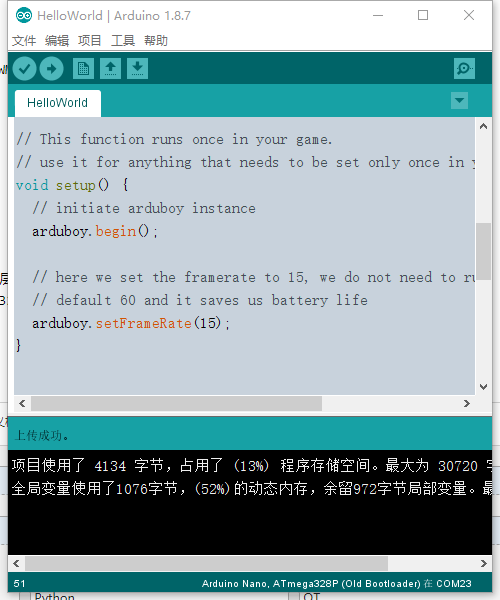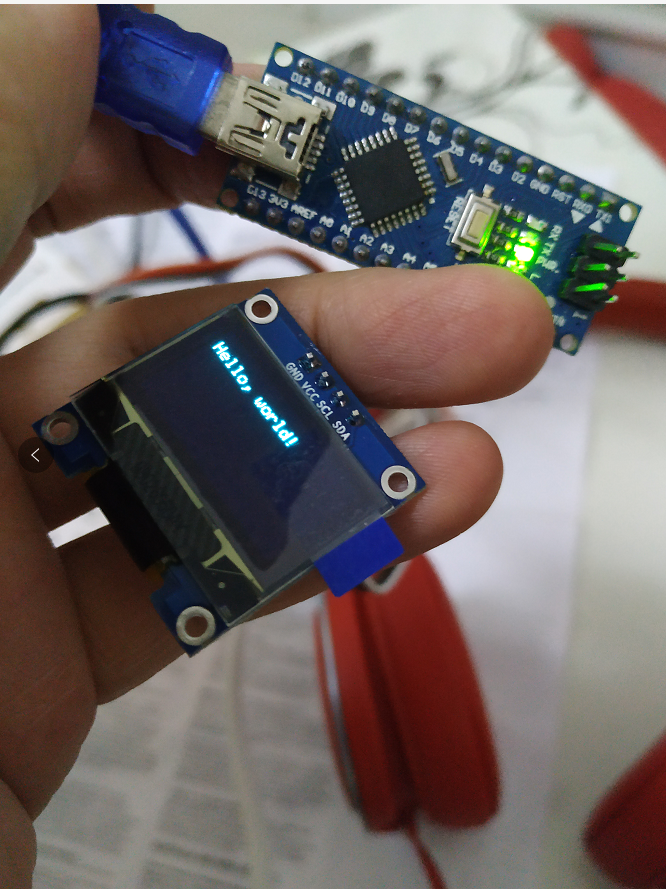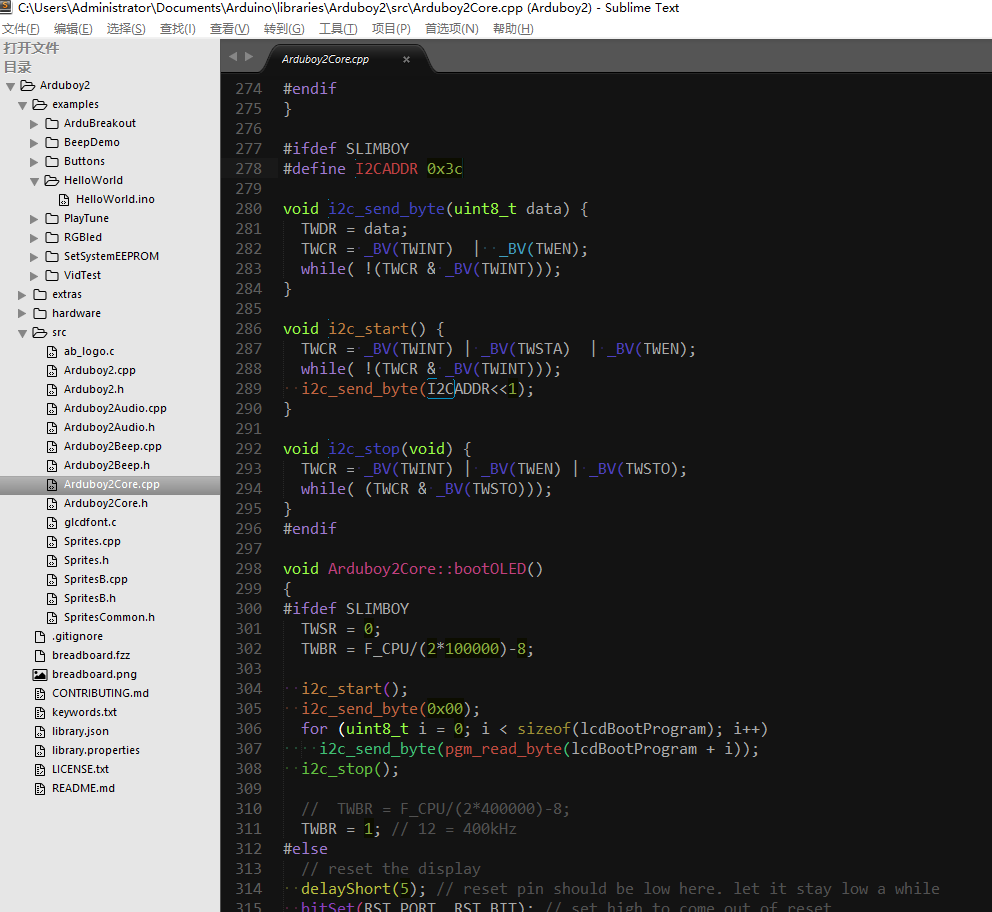尝试自己做一个复古游戏机Arduboy学习之路 1.NANO+I2C_OLED
尝试自己做一个复古游戏机Arduboy学习之路 1.NANO+I2C_OLED

手里只有arduino micro板子和I2C接口的OLED,而Arduboy用的OLED是SPI接口的,需要修改底层。
买了SPI接口的OLED还在路上,手痒怎么办。
看到一个帖子【如果但不开,就需要FQ看】:
https://community.arduboy.com/t/arduboy-on-arduino-nano-i-c-display/5532
功能是用NANO+I2C接口的OLED做。
但是楼主说法因为换了内核,好多bug,比如内存太小有些游戏不能忘,绿色LED不会PWM控制等等。
但是还是值得尝试一下
虽然帖子不好打开,但是github在国内还是容易打开的,顺利下载了源码:
https://github.com/harbaum/Arduboy2
README内帖子内也有接线图,也有fritzing的原图直接可以打开

很兴奋,下载了hellowworld源码到我的micro板子上,结果没驱动起来OLED,估计底层需要修改,先挖坑

算了,先找个NANO板子试试代码吧

烧录成功,而且OLED也成功点亮,显示helloworld

成功了一大半,其它的按键,LED,蜂鸣器都是其次,没难度。也就不研究了。
看下这个源码和官方Arduboy2的区别,看能不能修改到arduino micro板子上能用
这样和原装Arduboy对比都是ATMEGA32U4平台,只是修改一个OLED的SPI接口到I2C,应该代码不会出太多问题,只是液晶驱动速度可能会慢一些,至少可以先玩玩啊。
先看看这个源码,Arduboy2Core.h文件里面增加定义了如果内核是328p,就是当是NANO或者UNO时候的引脚定义。
/**
* @file Arduboy2Core.h
* \brief
* The Arduboy2Core class for Arduboy hardware initilization and control.
*/
#ifndef ARDUBOY2_CORE_H
#define ARDUBOY2_CORE_H
#include <Arduino.h>
#include <avr/power.h>
#include <avr/sleep.h>
#ifdef __AVR_ATmega328P__
#warning SLIMBOY!
#define SLIMBOY
#endif
// main hardware compile flags
#if !defined(ARDUBOY_10) && !defined(AB_DEVKIT)
/* defaults to Arduboy Release 1.0 if not using a boards.txt file
*
* we default to Arduboy Release 1.0 if a compile flag has not been
* passed to us from a boards.txt file
*
* if you wish to compile for the devkit without using a boards.txt
* file simply comment out the ARDUBOY_10 define and uncomment
* the AB_DEVKIT define like this:
*
* // #define ARDUBOY_10
* #define AB_DEVKIT
*/
#define ARDUBOY_10 //< compile for the production Arduboy v1.0
// #define AB_DEVKIT //< compile for the official dev kit
#endif
#ifdef SLIMBOY
#define RGB_ON HIGH /**< For digitially setting an RGB LED on using digitalWriteRGB() */
#define RGB_OFF LOW /**< For digitially setting an RGB LED off using digitalWriteRGB() */
#else
#define RGB_ON LOW /**< For digitially setting an RGB LED on using digitalWriteRGB() */
#define RGB_OFF HIGH /**< For digitially setting an RGB LED off using digitalWriteRGB() */
#endif
// ----- Arduboy pins -----
#ifdef ARDUBOY_10
#ifndef SLIMBOY
#define PIN_CS 12 // Display CS Arduino pin number
#define CS_PORT PORTD // Display CS port
#define CS_BIT PORTD6 // Display CS physical bit number
#define PIN_DC 4 // Display D/C Arduino pin number
#define DC_PORT PORTD // Display D/C port
#define DC_BIT PORTD4 // Display D/C physical bit number
#define PIN_RST 6 // Display reset Arduino pin number
#define RST_PORT PORTD // Display reset port
#define RST_BIT PORTD7 // Display reset physical bit number
#endif
#ifdef SLIMBOY
#define RED_LED 5 /**< The pin number for the red color in the RGB LED. */
#define GREEN_LED 7 /**< The pin number for the greem color in the RGB LED. */
#define BLUE_LED 6 /**< The pin number for the blue color in the RGB LED. */
#define RED_LED_PORT PORTD
#define RED_LED_BIT PORTD5
#define GREEN_LED_PORT PORTD
#define GREEN_LED_BIT PORTD7
#define BLUE_LED_PORT PORTD
#define BLUE_LED_BIT PORTD6
#else
#define RED_LED 10 /**< The pin number for the red color in the RGB LED. */
#define GREEN_LED 11 /**< The pin number for the greem color in the RGB LED. */
#define BLUE_LED 9 /**< The pin number for the blue color in the RGB LED. */
#define RED_LED_PORT PORTB
#define RED_LED_BIT PORTB6
#define GREEN_LED_PORT PORTB
#define GREEN_LED_BIT PORTB7
#define BLUE_LED_PORT PORTB
#define BLUE_LED_BIT PORTB5
#endif
// bit values for button states
// these are determined by the buttonsState() function
#define LEFT_BUTTON _BV(5) /**< The Left button value for functions requiring a bitmask */
#define RIGHT_BUTTON _BV(6) /**< The Right button value for functions requiring a bitmask */
#define UP_BUTTON _BV(7) /**< The Up button value for functions requiring a bitmask */
#define DOWN_BUTTON _BV(4) /**< The Down button value for functions requiring a bitmask */
#define A_BUTTON _BV(3) /**< The A button value for functions requiring a bitmask */
#define B_BUTTON _BV(2) /**< The B button value for functions requiring a bitmask */
#ifdef SLIMBOY
#define PIN_LEFT_BUTTON 15
#define LEFT_BUTTON_PORT PORTC
#define LEFT_BUTTON_PORTIN PINC
#define LEFT_BUTTON_DDR DDRC
#define LEFT_BUTTON_BIT PORTC1
#define PIN_RIGHT_BUTTON 3
#define RIGHT_BUTTON_PORT PORTD
#define RIGHT_BUTTON_PORTIN PIND
#define RIGHT_BUTTON_DDR DDRD
#define RIGHT_BUTTON_BIT PORTD3
#define PIN_UP_BUTTON 17
#define UP_BUTTON_PORT PORTC
#define UP_BUTTON_PORTIN PINC
#define UP_BUTTON_DDR DDRC
#define UP_BUTTON_BIT PORTC3
#define PIN_DOWN_BUTTON 2
#define DOWN_BUTTON_PORT PORTD
#define DOWN_BUTTON_PORTIN PIND
#define DOWN_BUTTON_DDR DDRD
#define DOWN_BUTTON_BIT PORTD2
#define PIN_A_BUTTON 4
#define A_BUTTON_PORT PORTD
#define A_BUTTON_PORTIN PIND
#define A_BUTTON_DDR DDRD
#define A_BUTTON_BIT PORTD4
#define PIN_B_BUTTON 16
#define B_BUTTON_PORT PORTC
#define B_BUTTON_PORTIN PINC
#define B_BUTTON_DDR DDRC
#define B_BUTTON_BIT PORTC2
#else
#define PIN_LEFT_BUTTON A2
#define LEFT_BUTTON_PORT PORTF
#define LEFT_BUTTON_PORTIN PINF
#define LEFT_BUTTON_DDR DDRF
#define LEFT_BUTTON_BIT PORTF5
#define PIN_RIGHT_BUTTON A1
#define RIGHT_BUTTON_PORT PORTF
#define RIGHT_BUTTON_PORTIN PINF
#define RIGHT_BUTTON_DDR DDRF
#define RIGHT_BUTTON_BIT PORTF6
#define PIN_UP_BUTTON A0
#define UP_BUTTON_PORT PORTF
#define UP_BUTTON_PORTIN PINF
#define UP_BUTTON_DDR DDRF
#define UP_BUTTON_BIT PORTF7
#define PIN_DOWN_BUTTON A3
#define DOWN_BUTTON_PORT PORTF
#define DOWN_BUTTON_PORTIN PINF
#define DOWN_BUTTON_DDR DDRF
#define DOWN_BUTTON_BIT PORTF4
#define PIN_A_BUTTON 7
#define A_BUTTON_PORT PORTE
#define A_BUTTON_PORTIN PINE
#define A_BUTTON_DDR DDRE
#define A_BUTTON_BIT PORTE6
#define PIN_B_BUTTON 8
#define B_BUTTON_PORT PORTB
#define B_BUTTON_PORTIN PINB
#define B_BUTTON_DDR DDRB
#define B_BUTTON_BIT PORTB4
#endif
#ifdef SLIMBOY
#define PIN_SPEAKER_1 9 /**< The pin number of the first lead of the speaker */
#define PIN_SPEAKER_2 11 /**< The pin number of the second lead of the speaker */
#define SPEAKER_1_PORT PORTB
#define SPEAKER_1_DDR DDRB
#define SPEAKER_1_BIT PORTB1
#define SPEAKER_2_PORT PORTB
#define SPEAKER_2_DDR DDRB
#define SPEAKER_2_BIT PORTB3
#else
#define PIN_SPEAKER_1 5 /**< The pin number of the first lead of the speaker */
#define PIN_SPEAKER_2 13 /**< The pin number of the second lead of the speaker */
#define SPEAKER_1_PORT PORTC
#define SPEAKER_1_DDR DDRC
#define SPEAKER_1_BIT PORTC6
#define SPEAKER_2_PORT PORTC
#define SPEAKER_2_DDR DDRC
#define SPEAKER_2_BIT PORTC7
#endif
// -----------------------
// ----- DevKit pins -----
#elif defined(AB_DEVKIT)
#define PIN_CS 6 // Display CS Arduino pin number
#define CS_PORT PORTD // Display CS port
#define CS_BIT PORTD7 // Display CS physical bit number
#define PIN_DC 4 // Display D/C Arduino pin number
#define DC_PORT PORTD // Display D/C port
#define DC_BIT PORTD4 // Display D/C physical bit number
#define PIN_RST 12 // Display reset Arduino pin number
#define RST_PORT PORTD // Display reset port
#define RST_BIT PORTD6 // Display reset physical bit number
#define SPI_MOSI_PORT PORTB
#define SPI_MOSI_BIT PORTB2
#define SPI_SCK_PORT PORTB
#define SPI_SCK_BIT PORTB1
// map all LEDs to the single TX LED on DEVKIT
#define RED_LED 17
#define GREEN_LED 17
#define BLUE_LED 17
#define BLUE_LED_PORT PORTB
#define BLUE_LED_BIT PORTB0
// bit values for button states
// these are determined by the buttonsState() function
#define LEFT_BUTTON _BV(5)
#define RIGHT_BUTTON _BV(2)
#define UP_BUTTON _BV(4)
#define DOWN_BUTTON _BV(6)
#define A_BUTTON _BV(1)
#define B_BUTTON _BV(0)
// pin values for buttons, probably shouldn't use these
#define PIN_LEFT_BUTTON 9
#define LEFT_BUTTON_PORT PORTB
#define LEFT_BUTTON_PORTIN PINB
#define LEFT_BUTTON_DDR DDRB
#define LEFT_BUTTON_BIT PORTB5
#define PIN_RIGHT_BUTTON 5
#define RIGHT_BUTTON_PORT PORTC
#define RIGHT_BUTTON_PORTIN PINC
#define RIGHT_BUTTON_DDR DDRC
#define RIGHT_BUTTON_BIT PORTC6
#define PIN_UP_BUTTON 8
#define UP_BUTTON_PORT PORTB
#define UP_BUTTON_PORTIN PINB
#define UP_BUTTON_DDR DDRB
#define UP_BUTTON_BIT PORTB4
#define PIN_DOWN_BUTTON 10
#define DOWN_BUTTON_PORT PORTB
#define DOWN_BUTTON_PORTIN PINB
#define DOWN_BUTTON_DDR DDRB
#define DOWN_BUTTON_BIT PORTB6
#define PIN_A_BUTTON A0
#define A_BUTTON_PORT PORTF
#define A_BUTTON_PORTIN PINF
#define A_BUTTON_DDR DDRF
#define A_BUTTON_BIT PORTF7
#define PIN_B_BUTTON A1
#define B_BUTTON_PORT PORTF
#define B_BUTTON_PORTIN PINF
#define B_BUTTON_DDR DDRF
#define B_BUTTON_BIT PORTF6
#define PIN_SPEAKER_1 A2
#define SPEAKER_1_PORT PORTF
#define SPEAKER_1_DDR DDRF
#define SPEAKER_1_BIT PORTF5
// SPEAKER_2 is purposely not defined for DEVKIT as it could potentially
// be dangerous and fry your hardware (because of the devkit wiring).
//
// Reference: https://github.com/Arduboy/Arduboy/issues/108
#endif
// --------------------
// ----- Pins common on Arduboy and DevKit -----
// Unconnected analog input used for noise by initRandomSeed()
#define RAND_SEED_IN A4
#define RAND_SEED_IN_PORT PORTF
#define RAND_SEED_IN_BIT PORTF1
// Value for ADMUX to read the random seed pin: 2.56V reference, ADC1
#define RAND_SEED_IN_ADMUX (_BV(REFS0) | _BV(REFS1) | _BV(MUX0))
// SPI interface
#define SPI_MISO_PORT PORTB
#define SPI_MISO_BIT PORTB3
#define SPI_MOSI_PORT PORTB
#define SPI_MOSI_BIT PORTB2
#define SPI_SCK_PORT PORTB
#define SPI_SCK_BIT PORTB1
#define SPI_SS_PORT PORTB
#define SPI_SS_BIT PORTB0
// --------------------
// OLED hardware (SSD1306)
#define OLED_PIXELS_INVERTED 0xA7 // All pixels inverted
#define OLED_PIXELS_NORMAL 0xA6 // All pixels normal
#define OLED_ALL_PIXELS_ON 0xA5 // all pixels on
#define OLED_PIXELS_FROM_RAM 0xA4 // pixels mapped to display RAM contents
#define OLED_VERTICAL_FLIPPED 0xC0 // reversed COM scan direction
#define OLED_VERTICAL_NORMAL 0xC8 // normal COM scan direction
#define OLED_HORIZ_FLIPPED 0xA0 // reversed segment re-map
#define OLED_HORIZ_NORMAL 0xA1 // normal segment re-map
// -----
#define WIDTH 128 /**< The width of the display in pixels */
#define HEIGHT 64 /**< The height of the display in pixels */
#define COLUMN_ADDRESS_END (WIDTH - 1) & 127 // 128 pixels wide
#define PAGE_ADDRESS_END ((HEIGHT/8)-1) & 7 // 8 pages high
/** \brief
* Eliminate the USB stack to free up code space.
*
* \note
* **WARNING:** Removing the USB code will make it impossible for sketch
* uploader programs to automatically force a reset into the bootloader!
* This means that a user will manually have to invoke a reset in order to
* upload a new sketch, after one without USB has be been installed.
* Be aware that the timing for the point that a reset must be initiated can
* be tricky, which could lead to some frustration on the user's part.
*
* \details
* \parblock
* This macro will cause the USB code, normally included in the sketch as part
* of the standard Arduino environment, to be eliminated. This will free up a
* fair amount of program space, and some RAM space as well, at the expense of
* disabling all USB functionality within the sketch (except as power input).
*
* The macro should be placed before the `setup()` function definition:
*
* \code{.cpp}
* #include <Arduboy2.h>
*
* Arduboy2 arduboy;
*
* // (Other variable declarations, etc.)
*
* // Eliminate the USB stack
* ARDUBOY_NO_USB
*
* void setup() {
* arduboy.begin();
* // any additional setup code
* }
* \endcode
*
* As stated in the warning above, without the USB code an uploader program
* will be unable to automatically force a reset into the bootloader to upload
* a new sketch. The user will have to manually invoke a reset. In addition to
* eliminating the USB code, this macro will check if the DOWN button is held
* when the sketch first starts and, if so, will call `exitToBootloader()` to
* start the bootloader for uploading. This makes it easier for the user than
* having to press the reset button.
*
* However, to make it even more convenient for a user to invoke the bootloader
* it is highly recommended that a sketch using this macro include a menu or
* prompt that allows the user to press the DOWN button within the sketch,
* which should cause `exitToBootloader()` to be called.
*
* At a minimum, the documentation for the sketch should clearly state that a
* manual reset will be required, and give detailed instructions on what the
* user must do to upload a new sketch.
* \endparblock
*
* \see Arduboy2Core::exitToBootloader()
*/
#define ARDUBOY_NO_USB int main() __attribute__ ((OS_main)); \
int main() { \
Arduboy2Core::mainNoUSB(); \
return 0; \
}
/** \brief
* Lower level functions generally dealing directly with the hardware.
*
* \details
* This class is inherited by Arduboy2Base and thus also Arduboy2, so wouldn't
* normally be used directly by a sketch.
*
* \note
* A friend class named _Arduboy2Ex_ is declared by this class. The intention
* is to allow a sketch to create an _Arduboy2Ex_ class which would have access
* to the private and protected members of the Arduboy2Core class. It is hoped
* that this may eliminate the need to create an entire local copy of the
* library, in order to extend the functionality, in most circumstances.
*/
class Arduboy2Core
{
friend class Arduboy2Ex;
public:
Arduboy2Core();
/** \brief
* Idle the CPU to save power.
*
* \details
* This puts the CPU in _idle_ sleep mode. You should call this as often
* as you can for the best power savings. The timer 0 overflow interrupt
* will wake up the chip every 1ms, so even at 60 FPS a well written
* app should be able to sleep maybe half the time in between rendering
* it's own frames.
*/
void static idle();
/** \brief
* Put the display into data mode.
*
* \details
* When placed in data mode, data that is sent to the display will be
* considered as data to be displayed.
*
* \note
* This is a low level function that is not intended for general use in a
* sketch. It has been made public and documented for use by derived
* classes.
*
* \see LCDCommandMode() SPItransfer()
*/
void static LCDDataMode();
/** \brief
* Put the display into command mode.
*
* \details
* When placed in command mode, data that is sent to the display will be
* treated as commands.
*
* See the SSD1306 controller and OLED display documents for available
* commands and command sequences.
*
* Links:
*
* - https://www.adafruit.com/datasheets/SSD1306.pdf
* - http://www.buydisplay.com/download/manual/ER-OLED013-1_Series_Datasheet.pdf
*
* \note
* This is a low level function that is not intended for general use in a
* sketch. It has been made public and documented for use by derived
* classes.
*
* \see LCDDataMode() sendLCDCommand() SPItransfer()
*/
void static LCDCommandMode();
/** \brief
* Transfer a byte to the display.
*
* \param data The byte to be sent to the display.
*
* \details
* Transfer one byte to the display over the SPI port and wait for the
* transfer to complete. The byte will either be interpreted as a command
* or as data to be placed on the screen, depending on the command/data
* mode.
*
* \see LCDDataMode() LCDCommandMode() sendLCDCommand()
*/
void static SPItransfer(uint8_t data);
/** \brief
* Turn the display off.
*
* \details
* The display will clear and be put into a low power mode. This can be
* used to extend battery life when a game is paused or when a sketch
* doesn't require anything to be displayed for a relatively long period
* of time.
*
* \see displayOn()
*/
void static displayOff();
/** \brief
* Turn the display on.
*
* \details
* Used to power up and reinitialize the display after calling
* `displayOff()`.
*
* \note
* The previous call to `displayOff()` will have caused the display's
* buffer contents to be lost. The display will have to be re-painted,
* which is usually done by calling `display()`.
*
* \see displayOff()
*/
void static displayOn();
/** \brief
* Get the width of the display in pixels.
*
* \return The width of the display in pixels.
*/
constexpr uint8_t static width() { return WIDTH; }
/** \brief
* Get the height of the display in pixels.
*
* \return The height of the display in pixels.
*/
constexpr uint8_t static height() { return HEIGHT; }
/** \brief
* Get the current state of all buttons as a bitmask.
*
* \return A bitmask of the state of all the buttons.
*
* \details
* The returned mask contains a bit for each button. For any pressed button,
* its bit will be 1. For released buttons their associated bits will be 0.
*
* The following defined mask values should be used for the buttons:
*
* LEFT_BUTTON, RIGHT_BUTTON, UP_BUTTON, DOWN_BUTTON, A_BUTTON, B_BUTTON
*/
uint8_t static buttonsState();
/** \brief
* Paint 8 pixels vertically to the display.
*
* \param pixels A byte whose bits specify a vertical column of 8 pixels.
*
* \details
* A byte representing a vertical column of 8 pixels is written to the
* display at the current page and column address. The address is then
* incremented. The page/column address will wrap to the start of the
* display (the top left) when it increments past the end (lower right).
*
* The least significant bit represents the top pixel in the column.
* A bit set to 1 is lit, 0 is unlit.
*
* Example:
*
* X = lit pixels, . = unlit pixels
*
* blank() paint8Pixels() 0xFF, 0, 0xF0, 0, 0x0F
* v TOP LEFT corner (8x9) v TOP LEFT corner
* . . . . . . . . (page 1) X . . . X . . . (page 1)
* . . . . . . . . X . . . X . . .
* . . . . . . . . X . . . X . . .
* . . . . . . . . X . . . X . . .
* . . . . . . . . X . X . . . . .
* . . . . . . . . X . X . . . . .
* . . . . . . . . X . X . . . . .
* . . . . . . . . (end of page 1) X . X . . . . . (end of page 1)
* . . . . . . . . (page 2) . . . . . . . . (page 2)
*/
void static paint8Pixels(uint8_t pixels);
/** \brief
* Paints an entire image directly to the display from program memory.
*
* \param image A byte array in program memory representing the entire
* contents of the display.
*
* \details
* The contents of the specified array in program memory is written to the
* display. Each byte in the array represents a vertical column of 8 pixels
* with the least significant bit at the top. The bytes are written starting
* at the top left, progressing horizontally and wrapping at the end of each
* row, to the bottom right. The size of the array must exactly match the
* number of pixels in the entire display.
*
* \see paint8Pixels()
*/
void static paintScreen(const uint8_t *image);
/** \brief
* Paints an entire image directly to the display from an array in RAM.
*
* \param image A byte array in RAM representing the entire contents of
* the display.
* \param clear If `true` the array in RAM will be cleared to zeros upon
* return from this function. If `false` the RAM buffer will remain
* unchanged. (optional; defaults to `false`)
*
* \details
* The contents of the specified array in RAM is written to the display.
* Each byte in the array represents a vertical column of 8 pixels with
* the least significant bit at the top. The bytes are written starting
* at the top left, progressing horizontally and wrapping at the end of
* each row, to the bottom right. The size of the array must exactly
* match the number of pixels in the entire display.
*
* If parameter `clear` is set to `true` the RAM array will be cleared to
* zeros after its contents are written to the display.
*
* \see paint8Pixels()
*/
void static paintScreen(uint8_t image[], bool clear = false);
/** \brief
* Blank the display screen by setting all pixels off.
*
* \details
* All pixels on the screen will be written with a value of 0 to turn
* them off.
*/
void static blank();
/** \brief
* Invert the entire display or set it back to normal.
*
* \param inverse `true` will invert the display. `false` will set the
* display to no-inverted.
*
* \details
* Calling this function with a value of `true` will set the display to
* inverted mode. A pixel with a value of 0 will be on and a pixel set to 1
* will be off.
*
* Once in inverted mode, the display will remain this way
* until it is set back to non-inverted mode by calling this function with
* `false`.
*/
void static invert(bool inverse);
/** \brief
* Turn all display pixels on or display the buffer contents.
*
* \param on `true` turns all pixels on. `false` displays the contents
* of the hardware display buffer.
*
* \details
* Calling this function with a value of `true` will override the contents
* of the hardware display buffer and turn all pixels on. The contents of
* the hardware buffer will remain unchanged.
*
* Calling this function with a value of `false` will set the normal state
* of displaying the contents of the hardware display buffer.
*
* \note
* All pixels will be lit even if the display is in inverted mode.
*
* \see invert()
*/
void static allPixelsOn(bool on);
/** \brief
* Flip the display vertically or set it back to normal.
*
* \param flipped `true` will set vertical flip mode. `false` will set
* normal vertical orientation.
*
* \details
* Calling this function with a value of `true` will cause the Y coordinate
* to start at the bottom edge of the display instead of the top,
* effectively flipping the display vertically.
*
* Once in vertical flip mode, it will remain this way until normal
* vertical mode is set by calling this function with a value of `false`.
*
* \see flipHorizontal()
*/
void static flipVertical(bool flipped);
/** \brief
* Flip the display horizontally or set it back to normal.
*
* \param flipped `true` will set horizontal flip mode. `false` will set
* normal horizontal orientation.
*
* \details
* Calling this function with a value of `true` will cause the X coordinate
* to start at the left edge of the display instead of the right,
* effectively flipping the display horizontally.
*
* Once in horizontal flip mode, it will remain this way until normal
* horizontal mode is set by calling this function with a value of `false`.
*
* \see flipVertical()
*/
void static flipHorizontal(bool flipped);
/** \brief
* Send a single command byte to the display.
*
* \param command The command byte to send to the display.
*
* \details
* The display will be set to command mode then the specified command
* byte will be sent. The display will then be set to data mode.
* Multi-byte commands can be sent by calling this function multiple times.
*
* \note
* Sending improper commands to the display can place it into invalid or
* unexpected states, possibly even causing physical damage.
*/
void static sendLCDCommand(uint8_t command);
/** \brief
* Set the light output of the RGB LED.
*
* \param red,green,blue The brightness value for each LED.
*
* \details
* The RGB LED is actually individual red, green and blue LEDs placed
* very close together in a single package. By setting the brightness of
* each LED, the RGB LED can show various colors and intensities.
* The brightness of each LED can be set to a value from 0 (fully off)
* to 255 (fully on).
*
* \note
* \parblock
* Certain libraries that take control of the hardware timers may interfere
* with the ability of this function to properly control the RGB LED.
*_ArduboyPlaytune_ is one such library known to do this.
* The digitalWriteRGB() function will still work properly in this case.
* \endparblock
*
* \note
* \parblock
* Many of the Kickstarter Arduboys were accidentally shipped with the
* RGB LED installed incorrectly. For these units, the green LED cannot be
* lit. As long as the green led is set to off, setting the red LED will
* actually control the blue LED and setting the blue LED will actually
* control the red LED. If the green LED is turned fully on, none of the
* LEDs will light.
* \endparblock
*
* \see setRGBled(uint8_t, uint8_t) digitalWriteRGB() freeRGBled()
*/
void static setRGBled(uint8_t red, uint8_t green, uint8_t blue);
/** \brief
* Set the brightness of one of the RGB LEDs without affecting the others.
*
* \param color The name of the LED to set. The value given should be one
* of RED_LED, GREEN_LED or BLUE_LED.
*
* \param val The brightness value for the LED, from 0 to 255.
*
* \note
* In order to use this function, the 3 parameter version must first be
* called at least once, in order to initialize the hardware.
*
* \details
* This 2 parameter version of the function will set the brightness of a
* single LED within the RGB LED without affecting the current brightness
* of the other two. See the description of the 3 parameter version of this
* function for more details on the RGB LED.
*
* \see setRGBled(uint8_t, uint8_t, uint8_t) digitalWriteRGB() freeRGBled()
*/
void static setRGBled(uint8_t color, uint8_t val);
/** \brief
* Relinquish analog control of the RGB LED.
*
* \details
* Using the RGB LED in analog mode prevents further use of the LED in
* digital mode. This function will restore the pins used for the LED, so
* it can be used in digital mode.
*
* \see digitalWriteRGB() setRGBled()
*/
void static freeRGBled();
/** \brief
* Set the RGB LEDs digitally, to either fully on or fully off.
*
* \param red,green,blue Use value RGB_ON or RGB_OFF to set each LED.
*
* \details
* The RGB LED is actually individual red, green and blue LEDs placed
* very close together in a single package. This 3 parameter version of the
* function will set each LED either on or off, to set the RGB LED to
* 7 different colors at their highest brightness or turn it off.
*
* The colors are as follows:
*
* RED LED GREEN_LED BLUE_LED COLOR
* ------- --------- -------- -----
* RGB_OFF RGB_OFF RGB_OFF OFF
* RGB_OFF RGB_OFF RGB_ON Blue
* RGB_OFF RGB_ON RGB_OFF Green
* RGB_OFF RGB_ON RGB_ON Cyan
* RGB_ON RGB_OFF RGB_OFF Red
* RGB_ON RGB_OFF RGB_ON Magenta
* RGB_ON RGB_ON RGB_OFF Yellow
* RGB_ON RGB_ON RGB_ON White
*
* \note
* \parblock
* Using the RGB LED in analog mode will prevent digital control of the
* LED. To restore the ability to control the LED digitally, use the
* `freeRGBled()` function.
* \endparblock
*
* \note
* \parblock
* Many of the Kickstarter Arduboys were accidentally shipped with the
* RGB LED installed incorrectly. For these units, the green LED cannot be
* lit. As long as the green led is set to off, turning on the red LED will
* actually light the blue LED and turning on the blue LED will actually
* light the red LED. If the green LED is turned on, none of the LEDs
* will light.
* \endparblock
*
* \see digitalWriteRGB(uint8_t, uint8_t) setRGBled() freeRGBled()
*/
void static digitalWriteRGB(uint8_t red, uint8_t green, uint8_t blue);
/** \brief
* Set one of the RGB LEDs digitally, to either fully on or fully off.
*
* \param color The name of the LED to set. The value given should be one
* of RED_LED, GREEN_LED or BLUE_LED.
*
* \param val Indicates whether to turn the specified LED on or off.
* The value given should be RGB_ON or RGB_OFF.
*
* \details
* This 2 parameter version of the function will set a single LED within
* the RGB LED either fully on or fully off. See the description of the
* 3 parameter version of this function for more details on the RGB LED.
*
* \see digitalWriteRGB(uint8_t, uint8_t, uint8_t) setRGBled() freeRGBled()
*/
void static digitalWriteRGB(uint8_t color, uint8_t val);
/** \brief
* Initialize the Arduboy's hardware.
*
* \details
* This function initializes the display, buttons, etc.
*
* This function is called by begin() so isn't normally called within a
* sketch. However, in order to free up some code space, by eliminating
* some of the start up features, it can be called in place of begin().
* The functions that begin() would call after boot() can then be called
* to add back in some of the start up features, if desired.
* See the README file or documentation on the main page for more details.
*
* \see Arduboy2Base::begin()
*/
void static boot();
/** \brief
* Allow upload when the bootloader "magic number" could be corrupted.
*
* \details
* If the UP button is held when this function is entered, the RGB LED
* will be lit and timer 0 will be disabled, then the sketch will remain
* in a tight loop. This is to address a problem with uploading a new
* sketch, for sketches that interfere with the bootloader "magic number".
* The problem occurs with certain sketches that use large amounts of RAM.
*
* This function should be called after `boot()` in sketches that
* potentially could cause the problem.
*
* It is intended to replace the `flashlight()` function when more
* program space is required. If possible, it is more desirable to use
* `flashlight()`, so that the actual flashlight feature isn't lost.
*
* \see Arduboy2Base::flashlight() boot()
*/
void static safeMode();
/** \brief
* Delay for the number of milliseconds, specified as a 16 bit value.
*
* \param ms The delay in milliseconds.
*
* \details
* This function works the same as the Arduino `delay()` function except
* the provided value is 16 bits long, so the maximum delay allowed is
* 65535 milliseconds (about 65.5 seconds). Using this function instead
* of Arduino `delay()` will save a few bytes of code.
*/
void static delayShort(uint16_t ms) __attribute__ ((noinline));
/** \brief
* Exit the sketch and start the bootloader
*
* \details
* The sketch will exit and the bootloader will be started in command mode.
* The effect will be similar to pressing the reset button.
*
* This function is intended to be used to allow uploading a new sketch,
* when the USB code has been removed to gain more code space.
* Ideally, the sketch would present a "New Sketch Upload" menu or prompt
* telling the user to "Press and hold the DOWN button when the procedure
* to upload a new sketch has been initiated". The sketch would then wait
* for the DOWN button to be pressed and then call this function.
*
* \see ARDUBOY_NO_USB
*/
void static exitToBootloader();
// Replacement main() that eliminates the USB stack code.
// Used by the ARDUBOY_NO_USB macro. This should not be called
// directly from a sketch.
void static mainNoUSB();
protected:
// internals
void static setCPUSpeed8MHz();
void static bootSPI();
void static bootOLED();
void static bootPins();
void static bootPowerSaving();
};
#endif
这里面没有需要的OLED的驱动方式修改的地方,继续看Arduboy2Core.cpp

这里我们发现了增加OLED液晶驱动的部分
那么,要改到micro上,感觉主要就是这两个文件了,挖坑以后补


文章对您有帮助,开心可以打赏我,金额随意,欢迎来赏!
需要电子方面开发板/传感器/模块等硬件可以到我的淘宝店逛逛


